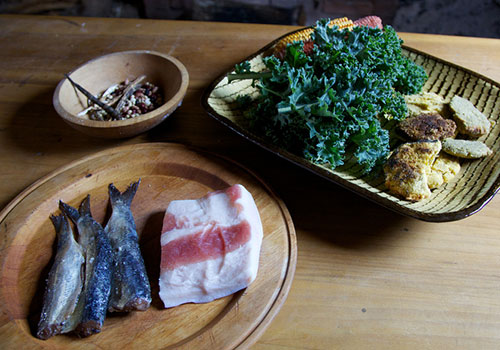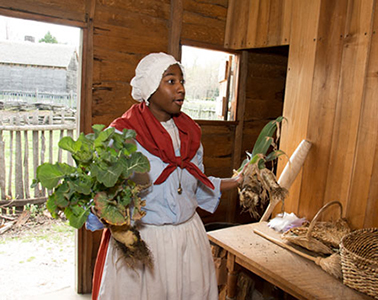What Did People Eat in the 1700s?

The food rations given to enslaved persons included salt pork, herring, and corn meal, as well as beans and greens they grew in their gardens.
In large part, the answer depended on a person’s social status. The diet of an enslaved person was quite different from that of a middle class or wealthy person. While the main food ingredients were the same for the social classes, what was added for flavor varied. For example, during the colonial period most people ate some type of corn cake. However, with extra money, one could purchase sugar, butter, and spices to enhance the recipe. You may be surprised to learn that colonial cooks could prepare just about everything we eat today — including ice cream! They cooked foods by frying, roasting, baking, grilling, and boiling just as we do in our homes.
During the 1700s, meals typically included pork, beef, lamb, fish, shellfish, chicken, corn, beans and vegetables, fruits, and numerous baked goods. Corn, pork, and beef were staples in most lower and middle class households. Dinner for these groups usually consisted of a stew made from a piece of pork and dried or fresh vegetables, and a starch such as corncake or corn pone. Fish was also a frequent dish in lower income households because it was inexpensive (or free) and a good source of protein. Living near the South River in London Town and the Chesapeake Bay allowed “lower sorts” people (a colonial term for poor people, servants, and enslaved persons) to fish, crab, and catch foods directly from the water.
If you think about it, so-called American food is really a blending of the foods of different cultures, reflecting the diverse groups of people who have come here over time. Historians believe that from the seventeenth through the nineteenth centuries, enslaved people brought or adapted many cooking techniques and ingredients from their native lands to their lives in America. Slow-cooked stews, deep-frying techniques, and vegetarian dishes are a few examples of the foodways enslaved people brought to Maryland. New ingredients brought to the colonies from Africa eventually became staples in the diets of Americans both enslaved and free. These include collard greens, black-eyed peas, peanuts, sweet potatoes, yams, cassava, kidney and lima beans, watermelon, rice, okra, sorghum, millet, pineapples, chili peppers, and sesame seeds. In many places in Africa it was common to slow cook stews and porridges. Enslaved people continued to cook foods in these familiar ways in the colonies. Slow cooking stews in a single pot did not require much work or attention. It was a very convenient way for enslaved people to prepare meals, as they often worked in their masters’ homes or fields for most of the day and were unable to tend to the fires back at their quarters. Perhaps even more important, an enslaved woman could stretch a small meat ration by cooking it into a stew with vegetables and grains. Slow-cooked stews and soups were also common meals for other lower sorts of people.

Food from the garden
Food rations for servants and slaves varied from owner to owner and from plantation to plantation. An enslaved person’s rations were often insufficient to sustain a healthy life. Most surviving documents that list these rations include pork as a main food. Depending on their status and job, the rations for enslaved people included from one-half to five pounds of meat (usually pork) per week. Think about that: a week’s supply of meat might equal the amount we use in one hamburger today! To survive, many enslaved people found ways to supplement their diets. Some planters allowed their slaves to hunt and fish — which meant that owners could provide less food. To improve the quantity and quality of foods in their diets, enslaved people frequently planted gardens around their quarters.


